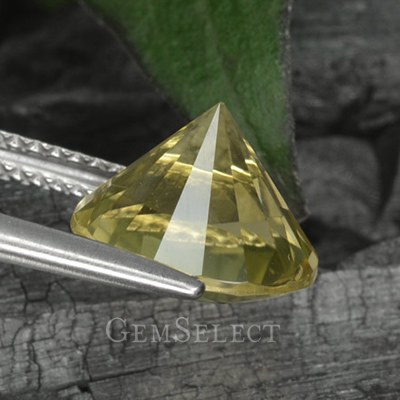Your Details
Your Details
|
Reviewed By Andreas Zabczyk
Colored Stones - A Gem's Pavilion, Girdle and CrownGone are the days of standard traditional gemstone cutting. Today's gemstones can be found in every shape, size and cut imaginable. Many gemstone types even have specialized cuts specifically designed to maximized their most desirable traits such as color, fire, brilliance and other optical effects. Evaluating the cutting of a stone requires the understanding of the anatomy of a gemstone. Below is an introduction to some important terminology used to describe the anatomy and cut of a gemstone. 
A Diamond-Cut Lemon Quartz Gem Held by the Girdle
The Gemstone PavilionThe pavilion is the lower portion of a gemstone that begins just below the 'girdle' (defined below). Pavilions can be cut and faceted in many different styles. Unlike diamond, most colored stones are cut with mixed styles, such as a step-cut pavilion combined with a scissor-cut crown or a coated pavilion with a concave-cut dome. The most popular mixed-cut style for colored stones today, typically combines a brilliant-cut crown with a step-cut pavilion. This style of cut brings out the color of the stone and also maximizes its brilliance and fire. The pavilion of a stone is usually cut with a culet facet. The culet facet is located at the lowest tip of a gem's pavilion. However, not all gemstones are cut with a culet. Many colored stones are cut to form more of an edge rather than a single point - often referred to as the the 'keel line'. When it comes to evaluation and grading, a keel line and a culet are considered to be one and the same. A culet is intended to help reduce the possibility of cleavage, particularly with gem types that exhibit perfect cleavage. Gems cut without a culet facet can be quite fragile even if they possess a moderate level of hardness. Other colored stones lacking distinct cleavage may still be cut with a culet simply to protect the tip, particularly if they exhibit brittle tenacity. The culet on a gem's pavilion is often described using terms such as "none", "small", "medium" or "large". Below is a gallery of images showing a small selection of the many different pavilion styles seen today:
The Gemstone GirdleThe girdle is the widest point of the circumference of a gemstone. It is the perimeter of the stone that separates the gem's pavilion from its crown. It is also usually the point where a stone is held when it is being examined. Girdles may be described as "thin" or "thick", or they may be more precisely specified as a percentage of the stone's diameter. The perfect girdle is characterized by a balanced thickness, maintaining a consistent width throughout the gem's perimeter. If the girdle is excessively thick, it can give the impression of a smaller stone compared to another of the same weight. On the other hand, a girdle that is too thin may increase the risk of chipping, unlike a girdle with a normal or medium proportion. Below is a gallery of images showing the ranges and proportions of girdles from thin to excessively thick: 
The Gemstone CrownThe crown is the upper portion of a gemstone that begins just above the girdle. The term 'table' is used to describe the flat top of the crown. The crown of a gemstone is typically raised, though some crowns may be cut very high, flat or even concave. In round and oval stones, the crown of a gemstone consists of 'star facets', 'bezel facets' and 'upper-girdle' facets. Star facets are the facets that surround the main table facet, they are typically triangular in shape. Upper-girdle facets, also known as the 'upper-halves', are facets just above the stone's girdle and are also usually triangular. The bezel facets, known as the 'crown mains', are the full four-sided facets between the upper-girdle and star facets. There are a few unique cutting styles seen today that are especially interesting, such as the 'Portuguese-cut'. Portuguese cut gemstones are faceted with an extra row of bezel facets, which result in more sparkle and color; this cutting style is typically seen only with large round or oval stones. Below are some examples of the different types of crown cutting styles seen today:
|
